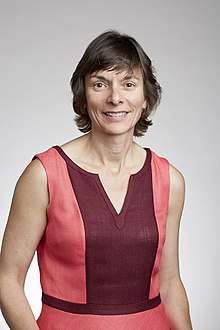Nicola Spaldin
Nicola Ann Spaldin (born 1969)[5][1] FRS is Professor of Materials Theory at ETH Zurich, known for her pioneering research on multiferroics.[6][4][7][8][9][10]
Nicola Spaldin | |
|---|---|
 Nicola Spaldin at the Royal Society admissions day in London, July 2017 | |
| Born | 1969 (age 50–51)[1] Sunderland, UK |
| Alma mater | University of Cambridge (BA) University of California, Berkeley (PhD) |
| Awards | James C. McGroddy Prize for New Materials (2010) Körber European Science Prize (2015) L'Oreal-UNESCO For Women in Science Award (2017) Swiss Science Prize Marcel Benoist (2019)[2] |
| Scientific career | |
| Fields |
|
| Institutions | ETH Zurich University of California, Santa Barbara Yale University |
| Thesis | Calculating the electronic properties of semiconductor nanostructures (1996) |
| Website | www |
Education and early life
A native of Sunderland, Tyne and Wear, England, Spaldin earned a Bachelor of Arts degree in Natural Sciences from the University of Cambridge in 1991, and a PhD in chemistry from the University of California, Berkeley in 1996.[11][12]
Career and research
Spaldin was inspired to search for multiferroics, magnetic ferroelectric materials, by a remark about potential collaboration made by a colleague studying ferroelectrics during her postdoctoral research studying magnetic phenomena at Yale University from 1996 to 1997.[13] She continued to develop the theory of these materials as a new faculty member at the University of California, Santa Barbara (UCSB), and in 2000 published (under her previous name, Hill) "a seminal article"[14] that for the first time explained why few such materials were known.[15] Following her theoretical predictions, in 2003 she was part of a team that experimentally demonstrated the multiferroic properties of bismuth ferrite.[16] She moved from UCSB to ETH Zurich in 2010.[12] Her publications are listed on Google scholar.[4]
Awards and honours
Spaldin was the 2010 winner of the American Physical Society's James C. McGroddy Prize for New Materials,[17] the Rössler Prize of the ETH Zurich Foundation in 2012, the 2015 winner of the Körber European Science Prize for "laying the theoretical foundation for the new family of multiferroic materials".[16][12][14] and one of the laureates of the 2017 L'Oréal-UNESCO Awards for Women in Science.[18] In November 2017 she was awarded the Lise-Meitner Lectureship of the Austrian and German Physical Societies in Vienna[19][20] and in 2019 she won the Swiss Science Prize Marcel Benoist[21]. In 2019, Spaldin was selected as the first Lead Editor of Physical Review Research.[22]
Spaldin is a Fellow of the American Physical Society (2008), the Materials Research Society (2011), the American Association for the Advancement of Science (2013)[12] and the Royal Society (2017)[23], and a Foreign Associate of the US National Academy of Engineering (2019).[24] She is an Honorary Fellow of Churchill College, Cambridge.
References
- Nicola Spaldin at Library of Congress Authorities
- https://marcel-benoist.ch/en/
- Spaldin, Nicola Ann (2005). "Materials Science: The Renaissance of Magnetoelectric Multiferroics". Science. 309 (5733): 391–392. doi:10.1126/science.1113357. ISSN 0036-8075. PMID 16020720. (subscription required)
- Nicola Spaldin publications indexed by Google Scholar

- Nicola Spaldin's ORCID 0000-0003-0709-9499
- Spaldin, Nicola A. (2003). Magnetic materials: fundamentals and device applications. Cambridge: Cambridge University Press. ISBN 9780521016582. OCLC 935635324.
- Nicola Spaldin publications from Europe PubMed Central
- Nicola Spaldin publications indexed by the Scopus bibliographic database. (subscription required)
- Wang, J.; Neaton, J. B.; Zheng, H.; Nagarajan, V.; Ogale, S. B.; Liu, B.; Viehland, D.; Vaithyanathan, V.; Schlom, D. G. (2003). "Epitaxial BiFeO₃ Multiferroic Thin Film Heterostructures". Science. 299 (5613): 1719–1722. Bibcode:2003Sci...299.1719W. doi:10.1126/science.1080615. ISSN 0036-8075. PMID 12637741. (subscription required)
- Ramesh, R.; Spaldin, Nicola A. (2007). "Multiferroics: progress and prospects in thin films". Nature Materials. 6 (1): 21–29. Bibcode:2007NatMa...6...21R. doi:10.1038/nmat1805. PMID 17199122. (subscription required)
- Hill, Nicola Ann (1996). Calculating the electronic properties of semiconductor nanostructures. oskicat.berkeley.edu (PhD thesis). University of California, Berkeley. OCLC 36371687.
- "Nicola Spaldin Curriculum vitae". ethz.ch. Archived from the original on 23 March 2017. retrieved 2015-06-16.
- Spaldin, Nicola A. (3 August 2017). "Fundamental Materials Research and the Course of Human Civilization". arXiv:1708.01325 [cond-mat.mtrl-sci].
- "Nicola Spaldin to receive the 2015 Körber Prize". koerber-stiftung.de. Archived from the original on 21 July 2015. retrieved 2015-07-16
- Hill, Nicola Ann (2000). "Why Are There so Few Magnetic Ferroelectrics?". Journal of Physical Chemistry B. 104 (29): 6694–6709. doi:10.1021/jp000114x. ISSN 1520-6106. (subscription required)
- Spaldin, Nicola (2015), "Multiferroics and me", In Person, Science, doi:10.1126/science.caredit.a1500156.
- "2010 James C. McGroddy Prize for New Materials Recipient: Nicola A. Spaldin". American Physical Society. Archived from the original on 21 July 2015. . Retrieved 2015-07-16.
- "Announcement of Laureates of 2017 L'Oréal-UNESCO For Women in Science Awards". UNESCO. Archived from the original on 5 October 2016.
- "Lise Meitner Lecture - Nicola Spaldin: New Materials for a New Age". physik.univie.ac.at. Retrieved 10 September 2019.
- Lise-Meitner-Lecture 2018 - Vortrag von Prof. Dr. Nicola Spaldin, retrieved 10 September 2019
- https://marcel-benoist.ch/en/
- "Nicola Spaldin Selected as Lead Editor of *Physical Review Research*". Physical Review Research. 30 April 2019. Retrieved 17 May 2019.
- Anon (2017). "Professor Nicola Spaldin FRS". royalsociety.org. Archived from the original on 23 May 2017. Retrieved 28 May 2017. One or more of the preceding sentences incorporates text from the royalsociety.org website where:
"All text published under the heading 'Biography' on Fellow profile pages is available under Creative Commons Attribution 4.0 International License" --"Royal Society Terms, conditions and policies". Archived from the original on 11 November 2016. Retrieved 9 March 2016.CS1 maint: BOT: original-url status unknown (link)
- "National Academy of Engineering Elects 86 Members and 18 Foreign Members". National Academy of Engineering. Retrieved 11 February 2019.